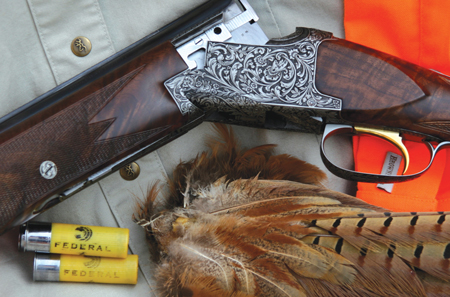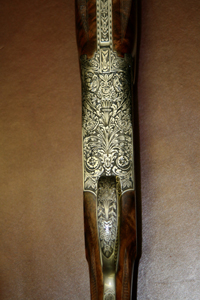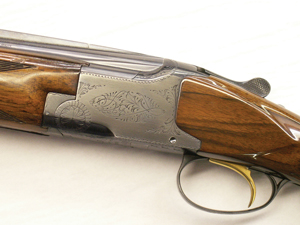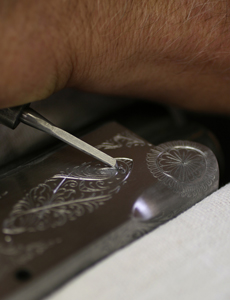
Even unlikely critics, like CNN Money.com lists the “Super” as one of the world’s finest shotguns.
John Moses Browning, arguably America’s premier firearm designer, first visualized the Superposed as an affordable over and under shotgun for American hunters and target shooters, in contrast to the much more expensive European models. Browning also reasoned the Superposed would be one of the last firearms regulated out of existence (but instead of modern day gun grabbers, Browning was more concerned by conservationists of the day who referred to Browning’s other design, the widely popular Auto-5 as “game exterminators”) as mentioned in Ned Schwing’s book, The Browning Superposed, the definitive word on the history of the Superposed from inception to the final days of production.

The Superposed endured many problematic issues even before its introduction, the most far reaching –finding a manufacturer to produce it. Browning approached Fabrique Nationale (FN), who was already producing not only Browning’s Auto 5, but was weighted down with military contracts. The two parties met several times to no avail, price being the major obstacle.
Speculation surfaced that Browning went elsewhere to get FN to agree to previously rejected terms. Ultimately, FN agreed with Browning’s terms and contracted to build the Superposed, the first order for 10,000 firearms at a cost of $30 each.
In the fall of 1926, John Moses traveled to Belgium to help speed production of the new shotgun. Two months later, he passed away, doing what he loved – working on guns.
From the first prototype of the Super in 1923, until his death and beyond, John Browning’s touch was indelible on the Superposed, but the work was not yet complete. Browning’s son, Val, following closely in his father’s footsteps, put many years in perfecting the trigger and the selector/ejector assembly, two of the elements that perplexed and haunted the elder Browning.
Even after production began on the Superposed, things weren’t as smooth as one might expect. The attention to detail and the amount of handwork required for each shotgun took time and manpower, slowing production to a crawl.
The Superposed was introduced commercially, in 1931, to the United States sporting market in four grades; Standard (Grade I), Pigeon Grade, Diana Grade, and Midas Grade. The Grade I retailed for $107.50 with the initial offering introduced in 12-gauge. The Superposed was offered standard with double triggers. Three other options were available; the single selective trigger which could be manipulated to fire either the top or bottom barrel first at the shooter’s discretion, the Twin-Single, which prevented the shotgun from doubling and a single, non-selective trigger, a raised matted solid rib or Browning’s “Non-Crossfire” ventilated rib for an additional $20, and one of three stock configurations; Field, Trap and Monte Carlo crafted in European walnut.
The Midas Grade retailed for $374. The response for the new shotgun, fueled by the outdoor writers of the day, was favorable.
In 1934, in the midst of the Great Depression, Browning dropped the price of the Grade I to $99.50, the next year the price was reduced further to $69.75. Other models were reduced accordingly. These reductions were to attract new customers and to steer customers from other established American manufacturers. The ploy worked. Sales nearly doubled from its first year and its popularity soared.

Along the way, in spite of ‘technical difficulties’ which included; Browning’s death, the Great Depression, the Nazi occupation of Belgium in May 1940 which decimated the FN facility, ceasing production – Browning sold more than 13,000 Supers in the U.S. establishing itself as a force to be reckoned with in the sporting arms market.
After World War II, and the rebuilding of FN, military sales began pouring into the new manufacturing facility. Welcome news for the war-torn gun maker, not so good for Browning. Much of their effort was busy filling military contracts and the Auto-5, which required much less attention than the labor-intensive Superposed.
By 1948, the Superposed’s presence was again felt in the U.S. However, loss of both manpower and machinery hampered shipments. The shotguns were much like those shipped before the war, but only in hunting grades or Grade I. In 1949 the 20-gauge found its way to the states, but again, only in Grade I configurations, change was in the air.
When the Super again hit the U.S., the model moniker had been changed – the entire lineup was known as Grade I through Grade V. Also in 1950, Browning began marketing highly engraved models known as their “Special Models Superposed.”
These shotguns were not just works of mechanical genius, but a canvas for the talents of some of the world’s finest artists/engravers, many being trained under the watchful tutelage of FN’s chief engraver, Felix Funken.
Each Superposed was engraved. The Grade I was embellished with a delicate scroll on both sides of the receiver. This work often fell to the least experienced engravers who could produce four per day.
The more elaborate work went to the craftsmen and women with more experience. The engraving pattern on the Grade II took a skilled engraver 15 hours to produce.
The higher the grade of gun, the more elaborate the engraving, the fancier the wood and so on. The Grade V offered full coverage engraving that took even master engravers more than 35 hours to complete.
The Grade VI, introduced in 1957, had its customers waiting months to receive their works of art, the gun featured a hand-matted rib, gold-plated firing pins, and ejector pins. The gun was stocked in high-grade walnut and hand checkered. The elaborate engraving scenes on the Grade VI were unique even if only slightly and included 18-karat gold inlays and deep engraved relief birds. The 12-gauge usually featured ducks and pheasants, the 20-gauge featured smaller game birds.
In 1959, Browning introduced the small gauges, 28 and 410, which sold out in six weeks.

By the end of the 1950s, FN had produced more than 86,000 Superposed shotguns, the majority of those being sold by Browning in the U.S.
If the 50s felt like change, the 60s showed it. Browning went public in 1961 and began diversifying its product line dabbling in boats, fishing rods, bows and arrows, as well as, new firearms under the Browning logo.
Browning Supers again were renamed Standard, Pigeon, Pointer, Diana and Midas grade. In 1966, the long tang trigger guard was replaced to a shorter trigger guard. This changed the physical appearance of the Superposed, as did the switch from the “Y” tang to the “U” shaped upper tang.
A shortage of high-grade French walnut, forced the change to Claro walnut of progressive grades.
The Super was selling like hotcakes, but nearly met its demise from its own maker’s hand – a decision to speed up the process of drying the wood by utilizing salt.
In case you didn’t know; steel and salt don’t mix and the effects from the salt-cured wood are not pretty. The metal is deeply pitted and the affected steel must be removed, welded and reshaped. The original salt-cured stock and forearm are useless and must be discarded.
Browning and its dedicated employees rolled up their sleeves and rectified the dreaded “Salt Wood” fiasco righting their wrong – instead of burying their heads in the sand.
Another hurdle cleared, Browning marched on to the tune of more than 11,000 guns annually for the entire decade, but once again change was coming…
The carefree days of the 60s came to a screeching halt as the 70s hit and even the Super could not avoid this recession.
Superposed sales dropped 25 percent in 1970. Browning’s competition had already begun to cut costs, but the Super held its own even though profits were down. As the 70s progressed, the other shoe dropped – sporting arms sales plummeted across the board. By 1975, only 1,276 Supers were sold.
Browning was going through some difficult times and dumped many of the losing subsidiaries started up in the 60s. Things went from bad to worse. Finally, in 1977 Browning was sold to FN, and the Superposed ceased being a production firearm, though FN still offers it as a custom shop firearm.
For its 46-year production run, Browning sold more than 255,000 Superposeds in North America. John Browning’s final legacy of an affordable over and under which became the Superposed, remains atop another list – as one of America’s all–time favorite shotguns.
This article appeared in the November 8, 2010 issue of Gun Digest the Magazine.

Next Step: Get your FREE Printable Target Pack
Enhance your shooting precision with our 62 MOA Targets, perfect for rifles and handguns. Crafted in collaboration with Storm Tactical for accuracy and versatility.
Subscribe to the Gun Digest email newsletter and get your downloadable target pack sent straight to your inbox. Stay updated with the latest firearms info in the industry.

![Best Concealed Carry Guns In 2025 [Field Tested] Wilson Combat EDC X9S 1](https://gundigest.com/wp-content/uploads/Wilson-Combat-EDC-X9S-1-324x160.jpg)


![Best 9mm Carbine: Affordable PCCs [Tested] Ruger Carbine Shooting](https://gundigest.com/wp-content/uploads/Ruger-Carbine-Shooting-100x70.jpg)
![Best AR-15: Top Options Available Today [Field Tested] Harrington and Richardson PSA XM177E2 feature](https://gundigest.com/wp-content/uploads/Harrington-and-Richardson-PSA-XM177E2-feature-100x70.jpg)

[…] then he has written hundreds of articles to include those featured in Gun Digest, AR Guns & Hunting, Bass Pro Shops OutdoorSite Library and an array of regional […]